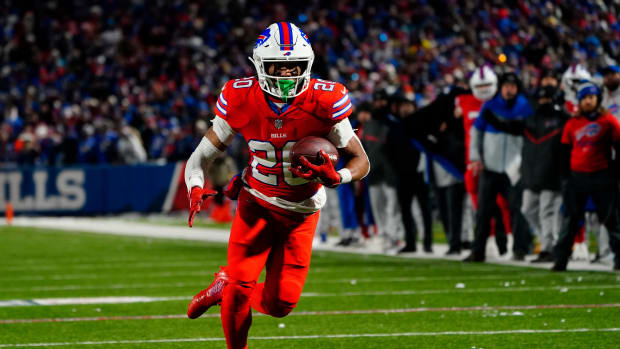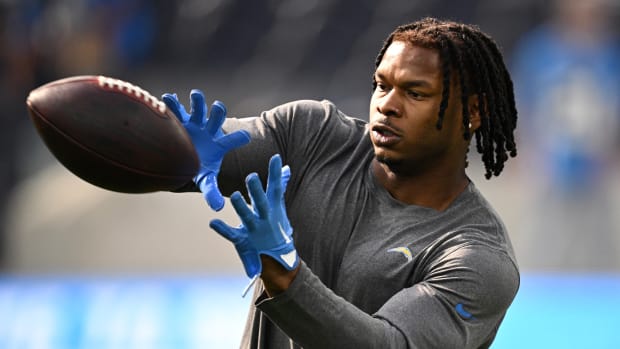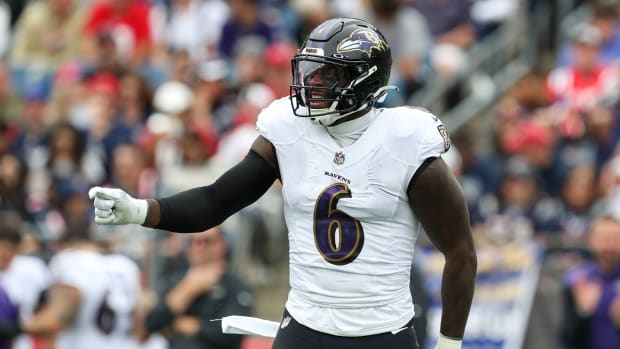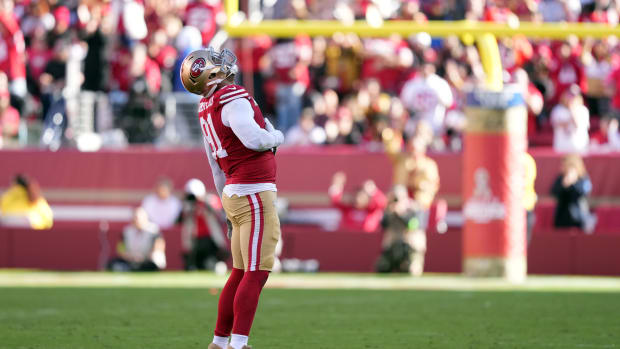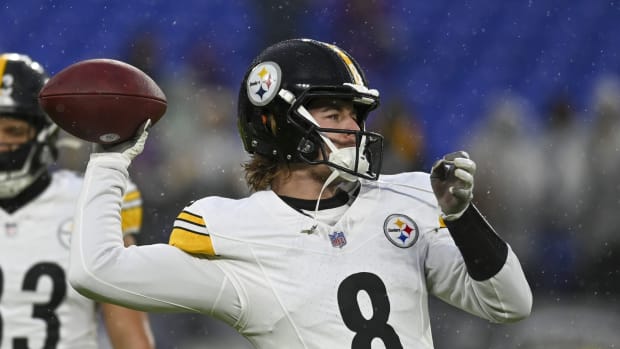Pressure Packages? Lockdown Corners? Here’s How to Beat ’em
As Gilbride and the Giants learned in December, any game plan against the Seattle D starts with trying to win the one-on-one battle on the corners. (Carlos M. Saavedra/Sports Illustrated/The MMQB)
NEW YORK CITY — Two weeks between the conference championship and the world championship: More than enough time to scheme, analyze, dissect, tweak—and produce the perfect Super Bowl game plan. Right?
“You’d be amazed at how quickly that time gets eaten up,” says Kevin Gilbride, who was the Giants’ offensive coordinator for their Super Bowl-winning teams in 2007 and 2011. “I said, ‘Oh, that second week, I’ll get to look at more film than I normally do.’ But it’s surprisingly not nearly as much time as you think.”
The art of game-planning comes down to this: Carefully culling a subset of the season-long playbook best-suited to beating the opponent. Seahawks offensive coordinator Darrell Bevell, for example, said Seattle likes to carry about 45 base plays in its weekly game plan—some of those plays having multiple iterations run out of different personnel groupings.
Bevell and the Broncos’ Adam Gase, Super Bowl XLVIII’s offensive coordinators, have different challenges this week. Gase, beyond the challenge of pitting the NFL’s No. 1 offense against the No. 1 defense, is scheming against a Seattle defense that thrives on simplicity and players’ winning one-on-one. Bevell, on the other hand, will guide his second-year quarterback against a Broncos defense that is at its best when it confuses the opponent with pressure packages and multiple fronts.
Gilbride, who recently retired from his post with the Giants, was part of one of the five coaching staffs that game-planned against both defenses this season—a 41-23 loss to the Broncos in Week 2, and a 23-0 loss to the Seahawks in Week 15, during the Giants’ injury-riddled 7-9 season. The MMQB asked Gilbride for his insight on the view from Bevell and Gase’s seats: How do you game-plan for these defenses?
VERSUS THE SEAHAWKS
Preparation for the Seahawks defense begins with this question: Can your wideouts win the one-on-one battles outside?
“If they can do that, it’s fairly easy,” Gilbride says. “But if they can’t—and I’m saying I don’t think [Denver’s receivers] are going to be able to—then the game plan becomes a lot more complex, because they’re going to have to do a lot of things, formationally and adjusting routes, to give their guys a chance to win.”
Seattle’s defense is based on not letting wideouts win. They ask cornerback Richard Sherman to lock down one side, and Byron Maxwell has stepped in admirably for the suspended Brandon Browner on the other. Here’s an example of how those DBs win: In the NFC Championship Game, the 49ers tried sending their strongest receiver, Anquan Boldin—the one with the best shot of winning this one-on-one battle—on a vertical route up the sideline in the fourth quarter, and Maxwell swatted it away.
Byron Maxwell (41) has stepped into a spotlight role for the Seahawks; Denver’s best shot is to look for mismatches to neutralize Seattle’s secondary. (John W. McDonough/Sports Illustrated/The MMQB)
Gilbride knows the ripple effect of not being able to win one-on-one matchups outside, because it happened to his Giants in December: The Seahawks come out ahead in the numbers game, having an extra defender either to use inside to thwart the run or to clog up passing lanes in the middle of the field. Seattle’s defensive front also gets a boost, because one way to neutralize a good pass rush is with quick three-step passes to the outside, but those options are not available if the wideouts aren’t winning.
The antidote to Seattle’s tight bump-and-run coverage is manipulating the offensive formation: motioning receivers into stack alignments so they’re not in press coverage at the line, and using formations with three receivers overloaded to one side. Seattle will usually play those formations, Gilbride says, by switching out of man-to-man into a zone coverage, with assignments based on the areas of the field where the receivers release into.
“It will take away a lot of explosiveness of down-the-field throws [for the offense],” Gilbride says. “They’ll throw it into a conservative zone defense—you’re playing what amounts to a three-deep zone—but now it gives your guys more of a chance to win.”
Gilbride sees a mismatch when the Broncos shift out tight end Julius Thomas (as The MMQB’s Andy Benoit detailed earlier this week)—either for Thomas, if the Seahawks try to cover him with a strong safety, or elsewhere on the field, if they keep a cornerback on him. But Gilbride doesn’t think Demaryius Thomas will be able to win against Sherman, citing Sherman’s size and Gilbride’s previously voiced opinion that Sherman has perfected the art of holding. If Sherman plays one side of the field, as he’s said he will, the Broncos could use Thomas more often on the opposite side.
The Seahawks defense may not be hard to figure out, but it’s hard to beat physically.
“Peyton will know what to do, but they’re going to find out early who can win,” Gilbride says. “Peyton is going to have to have a great day, and as long as it’s not real windy, I think he might be able to nickel and dime enough where they’ll be fine. But if that wind is howling like it can sometimes in the stadium, particularly when it starts going in a circle, it’s going to be tougher for him to fit the ball in those tight windows.”
VERSUS THE BRONCOS
The Broncos’ defense relies on pressure up front, so Seattle must rely on some seven-man protections and use the running back effectively. (John W. McDonough/Sports Illustrated/The MMQB)
Denver brings a completely different style on defense. The Broncos ranked in the bottom of the half of the league in yards allowed, and they have sustained key injuries down the stretch to outside linebacker Von Miller and cornerback Chris Harris. But Gilbride compares the challenge of game-planning for their scheme to the challenge of game-planning for the Jets and other defenses in the Ryan family tree.
“They depend on a sophisticated pressure package,” Gilbride said. “They try to overload their pass rush, give the illusion that they are coming from one side, then they bring the extra defenders from the other side. So you’re always one short.”
The Broncos also mix and match fronts, switching between three and four down linemen and odd and even spacing, creating more combinations from which to rush the quarterback.
The first objective for Seattle is to stay ahead of the chains and minimize the long-yardage situations when Denver unleashes these pressure packages. But in those inevitable third-and-throws, one approach that can help is what Gilbride calls “scan protections,” in which the running back goes from left to right, or right to left, to be in position to handle the overload blitz to either side. “They’ll also mix in some of the seven-man protections to increase the odds they’ll be able to have enough bodies to handle the pressure package,” he says.
Russell Wilson’s scrambling ability is Seattle’s ace in the hole against the Broncos. (Pouya Dianat for Sports Illustrated/The MMQB)
Seattle may have an advantage from quarterback Russell Wilson’s scrambling ability. Though Wilson was sacked four times by the 49ers in the NFC Championship Game, Gilbride says it would have been more if he were a typical drop-back passer: “As many times as San Francisco got to him, the amazing thing was you could see they were always cautious, fearful he was going to pull the ball down and run. You could see them being very cautious, very disciplined in their rush lanes, and making sure they didn’t rush by the quarterback.”
Two very different defenses. Two very different game plans. But both with the same end result in mind.






































